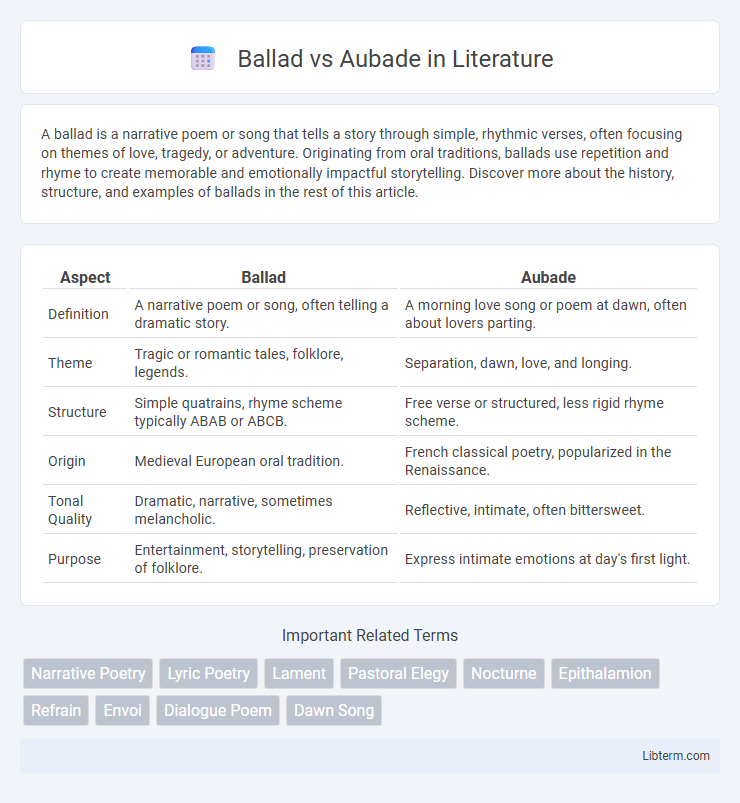A ballad is a narrative poem or song that tells a story through simple, rhythmic verses, often focusing on themes of love, tragedy, or adventure. Originating from oral traditions, ballads use repetition and rhyme to create memorable and emotionally impactful storytelling. Discover more about the history, structure, and examples of ballads in the rest of this article.
Table of Comparison
| Aspect | Ballad | Aubade |
|---|---|---|
| Definition | A narrative poem or song, often telling a dramatic story. | A morning love song or poem at dawn, often about lovers parting. |
| Theme | Tragic or romantic tales, folklore, legends. | Separation, dawn, love, and longing. |
| Structure | Simple quatrains, rhyme scheme typically ABAB or ABCB. | Free verse or structured, less rigid rhyme scheme. |
| Origin | Medieval European oral tradition. | French classical poetry, popularized in the Renaissance. |
| Tonal Quality | Dramatic, narrative, sometimes melancholic. | Reflective, intimate, often bittersweet. |
| Purpose | Entertainment, storytelling, preservation of folklore. | Express intimate emotions at day's first light. |
Introduction to Ballads and Aubades
Ballads are narrative poems or songs that tell stories, often focusing on themes of love, tragedy, or heroism, using a simple rhyme scheme and repeated refrains. Aubades, on the other hand, are lyrical poems or songs traditionally describing dawn or morning, typically portraying lovers parting at daybreak. Both forms have rich historical roots in medieval literature and continue to influence modern poetry and music.
Historical Origins of Ballads
Ballads originated in the medieval period as oral narrative poems sung to music, often recounting historical events, legends, and romantic tales. These folk songs were passed down through generations, shaping cultural traditions across Europe, especially in England and Scotland. The historical significance of ballads lies in their role as communal storytelling devices that preserved history and emotion before widespread literacy.
The Birth and Evolution of Aubades
Aubades originated in medieval France as morning love songs sung to lovers parting at dawn, evolving from the troubadour tradition of lyrical poetry. Over centuries, the aubade transformed from simple serenades to complex poetic forms reflecting themes of love, separation, and the transient nature of time. This evolution highlights the aubade's distinct role in literature, contrasting with the ballad's narrative storytelling through evolving stylistic and thematic layers.
Key Structural Differences
Ballads typically follow a narrative structure with quatrains consisting of alternating iambic tetrameter and trimeter lines, often employing a rhyme scheme such as ABAB or ABCB. Aubades, on the other hand, feature a morning love song format that emphasizes lyrical and emotional expression, frequently organized in free form or irregular stanza patterns rather than strict metrical schemes. The ballad's focus on storytelling contrasts with the aubade's thematic concentration on dawn and separation, reflected in their differing structural frameworks.
Themes in Ballads vs Aubades
Ballads often explore themes of love, tragedy, and heroism through narrative storytelling, emphasizing dramatic events and emotional intensity. Aubades focus on themes of parting and the bittersweet morning separation between lovers, capturing intimate moments of vulnerability and longing at dawn. These thematic differences highlight the ballad's emphasis on external action versus the aubade's introspective and temporal nature.
Musicality and Rhythm
Ballads often feature a steady, rhythmic meter with repetitive verses that enhance their narrative flow, making them ideal for storytelling through music. Aubades typically employ a more fluid and gentle rhythm, matching the early morning theme and evoking a serene, reflective mood. The distinct musicality of ballads relies on strong, consistent beats, while aubades focus on softer, melodic phrasing to capture dawn's tranquility.
Notable Ballad Examples
Notable ballad examples include "The Rime of the Ancient Mariner" by Samuel Taylor Coleridge, which combines narrative depth with lyrical intensity, and "Barbara Allen," a traditional folk ballad known for its storytelling and emotional resonance. These ballads often feature recurring refrains and dramatic plots centered on love, tragedy, or historical events. Their enduring popularity highlights the ballad's role in preserving oral traditions and exploring complex human experiences through musical and poetic expression.
Famous Aubade Works
Famous aubade works include John Donne's "The Sun Rising," which poetically captures the morning light as a symbol of love and separation. Another notable example is Philip Larkin's "Aubade," a contemplative poem reflecting on the inevitability of death during the early hours of dawn. These aubades uniquely emphasize the transition from night to day, often exploring themes of love, loss, and existential reflection.
Contemporary Adaptations
Contemporary adaptations of ballads often blend traditional storytelling with modern themes, incorporating genres such as pop, rock, and hip-hop to reach broader audiences. Aubades have evolved to explore varied expressions of dawn and awakening, with modern poets and songwriters using them to capture personal and societal transformations at daybreak. Both forms increasingly utilize multimedia platforms, enhancing the emotional impact through visual and auditory integration in digital formats.
Choosing Between Ballad and Aubade in Writing
Selecting between a ballad and an aubade depends on the desired narrative style and emotional tone. Ballads emphasize storytelling with rhythmic verses and often explore themes of tragedy, romance, or adventure, making them ideal for dramatic or folkloric content. Aubades focus on intimate morning scenes, typically expressing love or longing at dawn, suited for reflective, tender, or sensual moments in poetry.
Ballad Infographic

 libterm.com
libterm.com